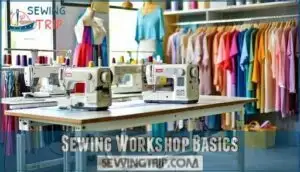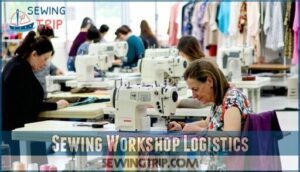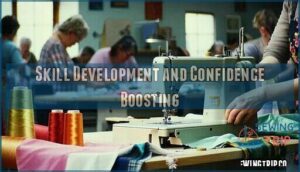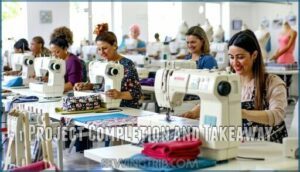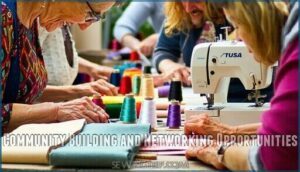This site is supported by our readers. We may earn a commission, at no cost to you, if you purchase through links.

You’ll learn techniques through hands-on projects, from basic stitches to complex garment construction.
These workshops offer specialized instruction in small groups, allowing personalized attention as you transform fabric into finished items.
You’ll use professional equipment while learning alongside others who share your interest in creating with cloth.
Workshops may last a few hours or several weeks depending on the complexity of skills taught.
Behind every successful seamstress is often that first workshop where they discovered the satisfaction of creating something with their own two hands.
Table Of Contents
Key Takeaways
- You’ll gain practical skills in a structured learning environment with expert guidance, where you can transform fabric into finished items through hands-on projects ranging from basic stitches to complex garment construction.
- You’ll find workshops available for every skill level—from complete beginners to advanced stitchers—with formats including one-day sessions, intensive courses spanning weeks, and both in-person and virtual options.
- You’ll need access to proper equipment including sewing machines, fabric scissors, measuring tools, and pressing equipment, which are often provided in workshops to ensure you can complete projects successfully.
- You’ll walk away with more than just a finished project—you’ll develop confidence, problem-solving abilities, and connections with a supportive community of fellow enthusiasts who share your passion.
Sewing Workshop Basics
You’ll find that sewing workshops offer focused environments where you can learn new techniques or improve existing skills with guidance from experienced instructors.
These structured sessions typically include hands-on projects that allow you to practice immediately, with all necessary materials often provided to guarantee you can create a finished item by the end of class.
Definition and Purpose
A sewing workshop’s purpose is to provide a structured environment where you’ll learn and practice stitching techniques.
These hands-on classes offer clear learning objectives focused on skill acquisition while fostering creative expression.
Whether you’re joining sewing for beginners or advanced sewing lessons, workshops create a supportive community engagement space.
You’ll develop practical abilities through guided instruction and collaborative learning, turning creative visions into tangible projects.
Types of Sewing Workshops
Diversity defines the sphere of sewing workshops, offering something for every skill level and interest.
You’ll find these popular formats in 2025:
- Beginner Workshops – From tote bags to pillowcases, perfect for sewing for beginners
- Quilting Workshops – Learn piecing, binding and quilting techniques
- Garment Construction – Make your own clothing from skirts to blazers
- Specialty Techniques – Master embroidery, draping, and knitwear skills
Benefits for Participants
Within a sewing workshop, you’ll discover far more than just stitching techniques.
Sewing workshops inspire creativity, build confidence, and connect you with a passionate community while mastering practical stitching skills.
You’ll experience confidence boosting as you develop sewing skills through project completion.
Many beginners find that learn to sew classes provide a supportive community building environment.
Beyond beginner sewing lessons, these workshops offer valuable networking opportunities with fellow enthusiasts who share your passion, creating connections that last beyond the classroom.
Sewing can also provide significant stress relief through mindful creation.
What is Sewing Workshop
A sewing workshop offers you a structured learning environment where skilled instructors guide participants through various stitching projects. Having explored the basics, let’s examine what actually constitutes a sewing workshop in today’s creative landscape.
These hands-on learning experiences have evolved from traditional classroom settings to diverse formats including online courses, in-person gatherings, and hybrid models. Workshop popularity has surged in 2025 as more people seek to develop practical skills while enjoying creative fulfillment.
Workshop variations cater to different interests:
- Project-focused sessions where you complete specific items like tote bags or aprons
- Technique-centered classes that teach specific sewing skills like zipper installation
- Machine-mastery workshops helping you understand your equipment fully
Workshop accessibility has improved dramatically with options available for all skill levels, making learn to sew opportunities more inclusive than ever before. You’ll find sewing classes designed specifically for your experience level and interests. Many workshops draw inspiration from leaders in the field, such as Linda Lee’s expertise in garment design.
Sewing Workshop Structure
You’ll find most sewing workshops organized into distinct sections that include class format, skill level requirements, materials provided, and instructor support.
These structured elements work together to create an effective learning environment where you can master techniques while completing projects under expert guidance.
Class Formats and Durations
Now that you understand what a sewing workshop offers, let’s examine how these creative sessions are structured.
Most sewing classes come in various formats to fit your schedule. You’ll find one-day workshops lasting 2-3 hours perfect for completing a simple tote bag, intensive courses spanning multiple weeks, and project-based sessions designed to specific items.
Many studios now offer flexible scheduling with hybrid options combining in-person and virtual learning. Some courses also emphasize fitting and alterations to customize garments.
Skill Levels and Prerequisites
Your workshop’s accessibility depends on how it’s structured for different skill levels.
Most sewing workshops accommodate various experience levels, from complete beginners to advanced stitchers.
- Beginner Basics: No prior experience needed; you’ll learn sewing fundamentals
- Material Comfort: Start with cotton before advancing to slippery fabrics
- Project Complexity: Progress from simple tote bags to detailed garments
- Skill-building: Each class builds on previous techniques
- Beginner-friendly: Many workshops specifically cater to first-timers
Your workshop should be structured to allow progression from simple to complex projects, ensuring that each class builds on previous techniques, and providing a beginner-friendly environment.
Materials and Supplies
While workshops vary by skill level, the right materials and supplies form the foundation of every sewing workshop.
You’ll typically find fabric kits, thread collections, and specialized tools awaiting participants. Most workshops include basic materials in the class cost ($100 at places like Brooklyn Sewing Academy).
For specialized sessions, instructors provide a required materials list upon enrollment. Many sewists source their supplies from various sewing kits for convenience.
Smart supply budgeting and proper tool maintenance guarantee your workshop investment delivers maximum value.
Instructor Qualifications and Support
While quality materials set the foundation, qualified instructors truly bring sewing workshops to life.
Behind every successful sewing education program stands an instructor with proper credentials and support. Your workshop instructor should have:
- Prior sewing knowledge and demonstrated technical expertise
- Completion of a full 3-day certification program
- Passion for teaching and strong pedagogical skills
- Access to ongoing support and resources through teachers-only website areas
Certified instructors receive valuable benefits including business marketing support, networking opportunities, and inclusion in searchable databases—helping you find the perfect sewing techniques demonstration expert for your skill level. Many instructors pursue Palmer Pletsch certification to enhance their expertise.
Sewing Workshop Logistics
You’ll need to plan the practical elements of your sewing workshop, from selecting an appropriate venue with adequate space to gathering all necessary equipment and managing registrations.
Before participants arrive with their enthusiasm and fabric scraps, you’ll want to create a thorough promotion strategy using social media platforms and in-store announcements to attract your target audience, which is crucial for the success of your sewing workshop.
Venue Selection and Setup
Once you’ve planned your workshop structure, finding the right venue is your next step.
Your space requirements should match your class size and activity type. Choose a venue with good lighting solutions, ensuring participants can see fine details clearly.
An ergonomic layout prevents sewing fatigue, while accessibility considerations guarantee everyone can participate comfortably.
Consider suitable product options when setting up your venue. Always implement safety protocols in your sewing studio for a positive workshop experience.
Equipment and Tool Requirements
Once you’ve secured your venue, you’ll need the right tools for your sewing workshop. Every participant needs access to a functioning sewing machine, fabric scissors, and measuring tools like tape measures and rulers.
Stock various thread types suitable for different fabrics and projects. Don’t forget pressing equipment—irons and ironing boards are musts for professional-looking results.
A good place to start is to find sewing machines that fit your budget. Having extra sewing materials and fabric on hand helps address unexpected needs during class.
Registration and Scheduling Processes
Setting up efficient registration and scheduling processes guarantees your sewing workshops run smoothly.
Create an online sign-up system with multiple payment options for participants’ convenience. Implement waitlist management when classes reach capacity.
Use calendar integration to prevent double-booking and help attendees plan ahead. Registration management software can automate confirmations and reminders, while maintaining class schedules that accommodate various skill levels and availability.
Projects with straight lines are best for beginners. Setting up efficient registration and scheduling processes is crucial for a smooth operation, and using online sign-up systems can enhance participant experience, while waitlist management ensures all interested attendees have a chance to join.
Marketing and Promotion Strategies
Boost your sewing workshop’s visibility with strategic marketing efforts.
Leverage social media platforms like Instagram and Pinterest to showcase your unique selling points through visual storytelling.
Implement in-store promotion with eye-catching displays and flyers featuring QR codes for easy registration.
Encourage community outreach through word-of-mouth recommendations and testimonials.
Always gather feedback after events to refine your promotion strategies and better connect with your target audience, focusing on strategic approaches.
Sewing Workshop Outcomes
You’ll walk away from a sewing workshop with practical skills and a completed project that showcases your new abilities.
These workshops also connect you with like-minded creators while providing instructors with additional revenue streams and increased store traffic, which can be considered an additional revenue.
Skill Development and Confidence Boosting
With your workshop venue and details in place, you’ll want to understand how these classes transform participants.
You’ll experience significant skill development during sewing workshops.
Learning new techniques and mastering sewing fundamentals builds confidence that extends beyond the classroom.
Problem solving becomes second nature as you troubleshoot tension issues or pattern alterations, and creative expression flourishes through fabric selection and design modifications, fostering personal growth and empowerment through sewing.
Project Completion and Takeaway
You’ll leave every sewing workshop with a tangible reward for your efforts – a completed project you can proudly display or use.
This finished project serves as both a reflection of your new skills and a template for future home applications.
Many workshops provide patterns and resources for continued practice, reinforcing what you’ve learned while building your creative confidence through additional sewing projects using similar tools and materials, which can be a tangible reward and help you develop new skills.
Community Building and Networking Opportunities
Sewing workshops act as vibrant hubs where your shared passion for stitching creates lasting connections.
You’ll find yourself part of a supportive sewing community where skill exchange happens naturally.
- Connect with fellow sewing enthusiasts who understand your excitement when discussing thread tension and fabric choices
- Participate in collaborative projects that showcase diverse techniques and perspectives
- Develop peer support networks for troubleshooting challenges and celebrating successes
Social interaction in these creative spaces often evolves into friendships that extend beyond the workshop walls, fostering a sense of community and supportive networks, and creating opportunities for collaborative projects.
Business Benefits and Revenue Growth
Many sewing workshops can transform your business bottom line. You’ll discover tangible sales increases while building brand awareness in your community.
These workshops offer several benefits, including customer acquisition, which can lead to a 10-20% broader appeal, and a workshop series that can generate $500-$1,000 in incremental revenue.
| Benefit | Revenue Impact |
|---|---|
| Customer Acquisition | 10-20% broader appeal |
| Workshop Series | $500-$1,000 incremental revenue |
| Pricing Strategy | 15-25% higher profit margins |
| Diversified Services | 20-30% small business growth |
These revenue generation opportunities create multiple sewing store revenue streams, ensuring sustained growth beyond your initial investment.
Frequently Asked Questions (FAQs)
How do I start a sewing workshop?
To start a sewing workshop, identify your target audience.
Secure a suitable space, gather necessary supplies, develop structured lesson plans.
And promote your classes through social media and local community boards.
Don’t forget insurance coverage.
Where is Linda Lee from sewing Workshop?
You might think she’s based in a fashion capital, but Linda Lee calls Topeka, Kansas her hometown.
She operates her pattern-making studio there, where she runs The Sewing Workshop with her talented team.
What is the hardest thing about sewing?
For beginners, precision is often the biggest challenge in sewing.
You’ll find that maintaining straight seams, matching patterns, and mastering tension control can feel frustrating at first, but practice builds confidence over time.
What do sewing classes teach?
Sewing classes teach you how to operate machines, master basic stitches, and follow patterns.
You’ll learn fabric selection, cutting techniques, seam construction, and project completion while developing skills for creating garments, quilts, or home décor items, which involves mastering basic stitches.
What is the best type of sewing machine for a sewing workshop?
Like a trusty companion on your creative journey, you’ll want a durable Janome HD-3000 or Brother mechanical machine for workshops.
They’re reliable workhorses with simple controls that can handle multiple users and various fabrics.
What types of organizational items are best for a sewing workshop?
Clear plastic bins, labeled fabric organizers, thread racks, and magnetic pin cushions keep your workshop orderly. You’ll also benefit from pegboards, rolling carts, and drawer dividers for tools and notions.
How much space is needed for a sewing workshop?
Just as birds need room to spread their wings, you’ll need 30-40 square feet per person in your sewing workshop.
This space allows for machines, cutting areas, and comfortable movement between stations, which is a complete concept for an efficient workspace.
What types of lighting are best for a sewing workshop?
You’ll need LED task lighting with 5000K-6500K color temperature to mimic natural daylight.
Position overhead lights for general illumination and adjustable lamps directly at your work area to eliminate shadows under your needle.
What safety measures should be taken when setting up a sewing workshop?
You’ll want proper electrical outlet covers to prevent catastrophic shocks. Arrange your space with clear pathways, keep sharp tools organized, install smoke detectors, and you’ll need first-aid kits readily available.
How to choose the right workshop?
Consider your skill level, project interests, and schedule when selecting a workshop.
Look for classes that offer beginner to advanced options, include necessary materials, and provide valuable techniques you’ll actually use.
Conclusion
Stepping into a sewing workshop isn’t just about learning to stitch—it’s about stitching your creative dreams into reality.
You’ll leave with more than just finished projects; you’ll gain confidence, skills, and connections that last a lifetime.
Whether you’re a beginner or experienced seamster, what’s a sewing workshop if not a gateway to self-expression?
Don’t just wear fashion—create it.
Your journey from fabric to finished masterpiece begins with that first class.

